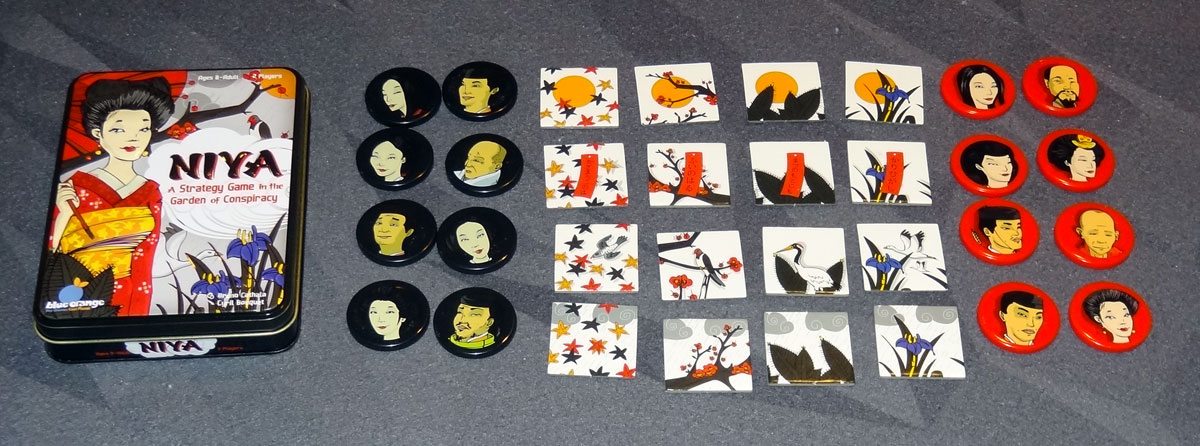About the game
Niya is a delightfully balanced game designed by Bruna Cathala and published by Blue Orange Games. It is a 2 player strategy game for players ages 7 and up. It takes place in classical Japan and is centered in a feud for power between two families, the Genji and Heike clans. For anyone that is intimidated by hardcore strategy games like chess, Niya offers a simple and accesible way to exercise the same strategy muscles.
Formal elements
The most important formal element in this game is the boundary, created by a 4×4 grid of 16 garden tiles. Each garden tile is composed of 2 elements, one plant (maple leaves, Cherry tree, Pine tree, Iris) and one poetic symbol (Rising sun, Poem flag, Bird, Rain cloud). Together, they create a mood that incorporates nature and symbolism through a unified color palette.

Objective: The goal of the game is to complete 4 tiles in row (horizontal, diagonal, vertical, square) OR block the opponent from further moves.
In terms of procedure, the first player chooses a garden tile from the outer grid and replaces it with a clan token (red or black symbolizing the Genji and Heike families). The next player must then exchange a token for a garden tile that shares an element in common with the tile that was just removed. On the following turns, players continue to replace garden tiles that have a common element with the tile removed by the previous player. The first player to complete 4 tiles in row (horizontal, diagonal, vertical, square) or block their opponent from further moves wins.
Types of Fun
This game delivers fun through challenge. It can be difficult to complete 4 tiles in row, especially when having to anticipate how your opponent may try to block you. It is both an offensive and defensive game, requiring strategy to win. However, the elements are simple enough to master. The sense of challenge is also aided by random elements. For example, the 4×4 tiles are laid out in random order. The boundary is always the same (4×4 tiles), but the placement of the elements within the boundary will be different for every game.
Balance
Niya is balanced in 4 ways:
- The challenge level is appropriate to the audience: The skills required are visual perception, abstract thinking, focus and attention, and strategy. These skills are accessible to 7 year olds and adults alike.
- The game can be won regardless of starting position: There are 12 starting positions (tiles on the outside of the grid) and one starting position is not necessarily easier to win with than another.
- There are multiple strategies and paths to victory: There are essentially 5 ways to win the game, by completing a horizontal, diagonal, vertical, or square with 4 tiles or by blocking the opponent from further moves. One path is not necessarily easier to win with than another.
- The objects in the game have the same cost/benefit ratio: Both players have 8 tiles they can use on the board and all 8 symbols on the board are equally balanced (each symbol appears 4 times across the 16 tiles).
Balance between game objects is less relevant for this game as there are no cards to trade or weapons to college. Therefore, transitive, intransitive, and fruity relationships are not featured in the architecture of the game.
Moment of success
This game is delightfully easy to learn, play, and enjoy. It can also be played in 5-15 minutes which lends itself well to being a repeat activity. It requires strategy and engages players through challenge, yet it is remarkably balanced. Not only is it balanced for the reasons stated above, it is also balanced through symmetry: 2 players and 2 family clans, 4 tiles to win, 8 symbols and 8 clan tokens, 16 tiles. The skills required to play are accessible to many, leveling the playing field for any two players regardless of age. My partner and I are both very competitive, and we found this game to be stimulating and interesting, while not favoring one or the other’s ability or skill. Our favorite moment while playing was when I was able to win as the underdog. I had been playing defensively for multiple rounds and in the end, ended up with a winning move that was created haphazardly by the previous defensive plays. Neither of us saw it coming. It is always delightful to be surprised at the last minute with who might be able to win!
Ideas for improvement
As mentioned, the balance is remarkably balanced and there are no improvements I would make on that front. One issue that came up while playing is that the symbols were not easily identifiable or easy to label. For example, we referred to “stars” or “starfish” while playing instead of maple leaves, “cactus” instead of pine tree, and “banner” instead of Tanzaku (poem flag). I’m sure this is not what the designers intended and ideally, there would be little confusion on what the elements are named. I really like the artistry of the game, so I wouldn’t recommend aesthetic changes. However, it might help to label the symbols on the tiles so that players know what to name them. Another solution may be to provide a card or legend that describes each of the symbols to players. These cards can be used as a reference while playing without disrupting the aesthetic balance of the tiles.



